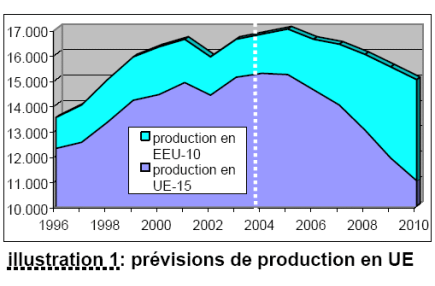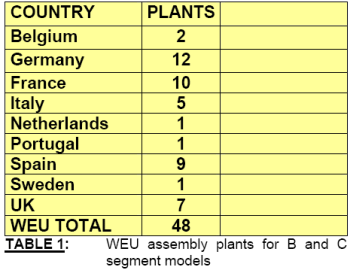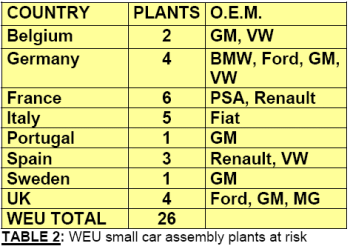Vous êtes ici:
HOME »
Articles »
étude de marché : La production en Europe de l’Est 1996-2010.
étude de marché : La production en Europe de l’Est 1996-2010.
étude de marché : La production en Europe de l’Est 1996-2010.
Summary:
The 2004 integration of eight countries in Central Europe into the European Union will accelerate the decentralisation of the European automotive industry. The market dynamics and possible consequences on assembly industry in Western European mainland (EU-15) are described. A forecast until 2010 is given.
Enlargement of the European Union (EU) In May 2004, eight new countries joined the European Union (EU-15, or WEU). Their offer to the automotive industry is well-trained operators and engineers at low wages, cheaper land for production sites and duty-free domestic production conditions.
What is more, cars built in these countries are from now on treated as domestic European products. This means that they are no more subject to cross-border taxes or other duties.
Production forecast
We have forecasted the production scenario until 2010 for these new EU member states and some member candidates, like Turkey (EEU). By 2010, total European production is supposed to consolidate at around 15 Million cars/year, compared to a production of 16 Million units in 2003.
We predict a rise in the share of these new EU member states and confirmed candidates for adhesion from 1.5 Million cars/year to 4.0 Million units per annum.

As a consequence of these two elements, in western EU countries, a production capacity of approx. 4 Million units, or 25%, a reorganisation of the production infra-structure is supposed to take place between 2006 and 2010. For better understanding of the market dynamics, we briefly recall here the past and currents moves in European vehicle production.
Decentralisation phases of EU automotive industry:
From the start of the 20th century to the 50ies, car production was concentrated in a few agglomerations (Paris, Turin, Stuttgart, Wolfsburg). From the 50ies to the 70ies, a first decentralisation move took place to the north-west (Belgium and Netherlands) and to the south (southern Italy). A second wave followed from the 70ies to the 90ies, characterised by an expansion to the Iberian peninsula (Spain and Portugal). Starting in the 90ies, a new decentralisation move turned east, with acquisitions in Romania (Dacia) and in the Czech Republic (Skoda), followed by the erection of new greenfield plants in Slovakia (VW), Hungary (Audi) and in Turkey (several).
In a growing market, this expansion had no immediate consequences on the Western European production capacity, and a number of new assembly plants were set-up in the core of WEU (smart, Hambach (F); Toyota, Valenciennes (F); BMW, Regensburg (D) and Leipzig (D); VW, Dresden (D) are just some examples).
However, in a scenario of a shrinking market after 2005, without compensation by increased export to outside the EU, consequences for older and unprofitable WEU assembly plants are more than likely.
EEU segment analysis
We have run an analysis by car segment on the anticipated 4 Million production volume in the enlargement part of the new EU. It shows that essentially two segments are concerned, that is the small (B) and lower-medium segment (C). In 2010, the combined B and C segment production volume will make up 3 out of the 4 million units built on an annual base. The rest being a number of van- and CDV-type vehicles with quite low technological complexity. The absence of high-tech content vehicles is obvious, with only a handful of A segment, sportcoup� and SUV cars.

Small car assembly characteristics
The small car assembly industry is characterised by high volumes, and therefore a need for lowest production cost possible. Unlike premium cars, these products having relatively low technological complexity are under tremendous price pressure. Due to high volumes, small cars are produced in a decentralised way, in several assembly plants. Therefore, the risk for a plant in an emerging industrial region is fairly low, because of possible transfer of trained operator core teams and know-how from assembly plants in industrial mainland.
Other typical risks of assembly plants in emerging industrial regions, like poor workforce education, logistics and unstable local markets are also quite low in EEU: a sufficient portion of the production volume is absorbed by the local market and exported to Eastern Europe (e.g. Skoda Octavia in the Czech Republic, Suzuki Swift in Hungary, Renault Clio in Slovenia, Dacia Logan in Romania).
Top-of-the-range car assembly characteristics:
Surprisingly, top-of-the-range cars are not only large cars in D, E and SUV segment, or sportscars, but more and more citycar-type vehicles with high technological content (light-weight materials and engines, outstanding electronics and safety features, infotainment, premium design) are entering the scene.
There is more than one reason why these top-of-the-range cars are produced in industrial mainland: they all are too complex for assembly in emerging industrial regions ; and large cars in D, E and SUV segment have high export rates to NAFTA and wealthy oil states. Both EU and non-EU customers expect WEU expertise in these cars, which is an important part in the sales philosophy.
Risk factors for WEU assembly plants producing B and C segment cars
In a scenario of a shrinking market after 2005, without compensation by increased export to outside the EU, the new EEU assembly capacities are a risk for Western assembly plants having more than three of the following five characteristics:
In our screening of 115 assembly plants in EU-25, 48 plants in the western part of EU (EU-15) are producing B and C segment vehicles..

Most of them (36) are located in continental European mainland, that is Germany, France, Italy and Spain. Seven more plants are located in the southern part of the UK.
By applying the above-mentioned criteria, we have identified 26 plants with an elevated risk level.

This means that today, one out of two plants for small car assembly is working in conditions that do not guarantee a long-term perspective. We have summarised the main characteristics of these plants in the following table.

click HERE for big graph
Summary:
The 2004 integration of eight countries in Central Europe into the European Union will accelerate the decentralisation of the European automotive industry. The market dynamics and possible consequences on assembly industry in Western European mainland (EU-15) are described. A forecast until 2010 is given.
Enlargement of the European Union (EU) In May 2004, eight new countries joined the European Union (EU-15, or WEU). Their offer to the automotive industry is well-trained operators and engineers at low wages, cheaper land for production sites and duty-free domestic production conditions.
What is more, cars built in these countries are from now on treated as domestic European products. This means that they are no more subject to cross-border taxes or other duties.
Production forecast
We have forecasted the production scenario until 2010 for these new EU member states and some member candidates, like Turkey (EEU). By 2010, total European production is supposed to consolidate at around 15 Million cars/year, compared to a production of 16 Million units in 2003.
We predict a rise in the share of these new EU member states and confirmed candidates for adhesion from 1.5 Million cars/year to 4.0 Million units per annum.

As a consequence of these two elements, in western EU countries, a production capacity of approx. 4 Million units, or 25%, a reorganisation of the production infra-structure is supposed to take place between 2006 and 2010. For better understanding of the market dynamics, we briefly recall here the past and currents moves in European vehicle production.
Decentralisation phases of EU automotive industry:
From the start of the 20th century to the 50ies, car production was concentrated in a few agglomerations (Paris, Turin, Stuttgart, Wolfsburg). From the 50ies to the 70ies, a first decentralisation move took place to the north-west (Belgium and Netherlands) and to the south (southern Italy). A second wave followed from the 70ies to the 90ies, characterised by an expansion to the Iberian peninsula (Spain and Portugal). Starting in the 90ies, a new decentralisation move turned east, with acquisitions in Romania (Dacia) and in the Czech Republic (Skoda), followed by the erection of new greenfield plants in Slovakia (VW), Hungary (Audi) and in Turkey (several).
In a growing market, this expansion had no immediate consequences on the Western European production capacity, and a number of new assembly plants were set-up in the core of WEU (smart, Hambach (F); Toyota, Valenciennes (F); BMW, Regensburg (D) and Leipzig (D); VW, Dresden (D) are just some examples).
However, in a scenario of a shrinking market after 2005, without compensation by increased export to outside the EU, consequences for older and unprofitable WEU assembly plants are more than likely.
EEU segment analysis
We have run an analysis by car segment on the anticipated 4 Million production volume in the enlargement part of the new EU. It shows that essentially two segments are concerned, that is the small (B) and lower-medium segment (C). In 2010, the combined B and C segment production volume will make up 3 out of the 4 million units built on an annual base. The rest being a number of van- and CDV-type vehicles with quite low technological complexity. The absence of high-tech content vehicles is obvious, with only a handful of A segment, sportcoup� and SUV cars.

Small car assembly characteristics
The small car assembly industry is characterised by high volumes, and therefore a need for lowest production cost possible. Unlike premium cars, these products having relatively low technological complexity are under tremendous price pressure. Due to high volumes, small cars are produced in a decentralised way, in several assembly plants. Therefore, the risk for a plant in an emerging industrial region is fairly low, because of possible transfer of trained operator core teams and know-how from assembly plants in industrial mainland.
Other typical risks of assembly plants in emerging industrial regions, like poor workforce education, logistics and unstable local markets are also quite low in EEU: a sufficient portion of the production volume is absorbed by the local market and exported to Eastern Europe (e.g. Skoda Octavia in the Czech Republic, Suzuki Swift in Hungary, Renault Clio in Slovenia, Dacia Logan in Romania).
Top-of-the-range car assembly characteristics:
Surprisingly, top-of-the-range cars are not only large cars in D, E and SUV segment, or sportscars, but more and more citycar-type vehicles with high technological content (light-weight materials and engines, outstanding electronics and safety features, infotainment, premium design) are entering the scene.
There is more than one reason why these top-of-the-range cars are produced in industrial mainland: they all are too complex for assembly in emerging industrial regions ; and large cars in D, E and SUV segment have high export rates to NAFTA and wealthy oil states. Both EU and non-EU customers expect WEU expertise in these cars, which is an important part in the sales philosophy.
Risk factors for WEU assembly plants producing B and C segment cars
In a scenario of a shrinking market after 2005, without compensation by increased export to outside the EU, the new EEU assembly capacities are a risk for Western assembly plants having more than three of the following five characteristics:
- it belongs to one of the Big Five (Fiat, Ford, GM, Renault, VW)
- it is relatively old (start before 1970)
- output is below 80% of its capacity
- wages on a high level, no flexible shift model
- limited or no product mix (with other cars outside the B and C segments)
In our screening of 115 assembly plants in EU-25, 48 plants in the western part of EU (EU-15) are producing B and C segment vehicles..

Most of them (36) are located in continental European mainland, that is Germany, France, Italy and Spain. Seven more plants are located in the southern part of the UK.
By applying the above-mentioned criteria, we have identified 26 plants with an elevated risk level.

This means that today, one out of two plants for small car assembly is working in conditions that do not guarantee a long-term perspective. We have summarised the main characteristics of these plants in the following table.

click HERE for big graph